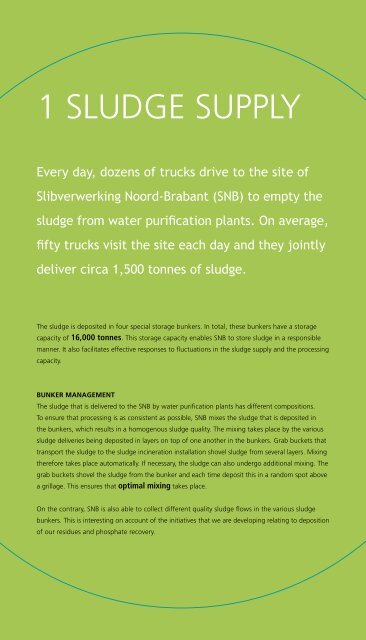The sludge incineraTion process - SNB
The sludge incineraTion process - SNB
The sludge incineraTion process - SNB
Create successful ePaper yourself
Turn your PDF publications into a flip-book with our unique Google optimized e-Paper software.
1 Sludge supply<br />
Every day, dozens of trucks drive to the site of<br />
Slibverwerking Noord-Brabant (<strong>SNB</strong>) to empty the<br />
<strong>sludge</strong> from water purification plants. On average,<br />
fifty trucks visit the site each day and they jointly<br />
deliver circa 1,500 tonnes of <strong>sludge</strong>.<br />
No risk of bad odours<br />
Sludge has a horrible odour. <strong>The</strong> area surrounding<br />
<strong>SNB</strong> must not be inconvenienced<br />
by that. <strong>SNB</strong> has taken various measures to<br />
prevent nuisance caused by bad odours.<br />
For example, the unloading areas have two<br />
interlinked doors. <strong>The</strong> outside door can only<br />
be opened if the inside door – that provides<br />
access to the bunker – is closed, and vice<br />
versa. This prevents the <strong>sludge</strong> odour from<br />
escaping outside. Furthermore, the air in<br />
the <strong>sludge</strong> bunkers is extracted by the four<br />
incineration lines of the <strong>sludge</strong> incineration<br />
installation and co-incinerated in the ovens.<br />
<strong>SNB</strong> also uses a biofilter that can neutralise<br />
odours.<br />
<strong>The</strong> <strong>sludge</strong> is deposited in four special storage bunkers. In total, these bunkers have a storage<br />
capacity of 16,000 tonnes. This storage capacity enables <strong>SNB</strong> to store <strong>sludge</strong> in a responsible<br />
manner. It also facilitates effective responses to fluctuations in the <strong>sludge</strong> supply and the <strong>process</strong>ing<br />
capacity.<br />
Bunker management<br />
<strong>The</strong> <strong>sludge</strong> that is delivered to the <strong>SNB</strong> by water purification plants has different compositions.<br />
To ensure that <strong>process</strong>ing is as consistent as possible, <strong>SNB</strong> mixes the <strong>sludge</strong> that is deposited in<br />
the bunkers, which results in a homogenous <strong>sludge</strong> quality. <strong>The</strong> mixing takes place by the various<br />
<strong>sludge</strong> deliveries being deposited in layers on top of one another in the bunkers. Grab buckets that<br />
transport the <strong>sludge</strong> to the <strong>sludge</strong> incineration installation shovel <strong>sludge</strong> from several layers. Mixing<br />
therefore takes place automatically. If necessary, the <strong>sludge</strong> can also undergo additional mixing. <strong>The</strong><br />
grab buckets shovel the <strong>sludge</strong> from the bunker and each time deposit this in a random spot above<br />
a grillage. This ensures that optimal mixing takes place.<br />
On the contrary, <strong>SNB</strong> is also able to collect different quality <strong>sludge</strong> flows in the various <strong>sludge</strong><br />
bunkers. This is interesting on account of the initiatives that we are developing relating to deposition<br />
of our residues and phosphate recovery.



